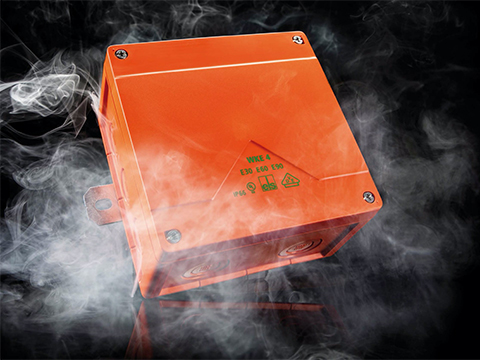
Posted to News on 13th Nov 2024, 13:30
Ensuring fire safety for electrical connections
Chris Lloyd, managing director at Spelsberg UK, explains the advantages of fire-resistant, surface-mounted enclosures in building design.

To protect electrical junctions in buildings from the threat of fire, embedding connections in concrete has been one of the possible solutions in the past, depending on the building design. While concrete is fire resistant, the challenges of access make inspection, as well as installation, more complex to achieve. Instead, fire-protected enclosures mounted directly onto a wall surface can make maintenance and installation significantly faster while maintaining the required safety standards.
In the event of a building fire, safety systems must continue operating for a prolonged period. As well as alarms to warn occupants and alert emergency services, lighting must remain active to highlight a safe exit route. Smoke and heat extraction systems might be relied on, as well as water booster systems to supply extinguishers, while dedicated elevators might need to safely transport fire crews.
All these systems need electrical power and protection of their supply during a blaze, potentially for an hour or more after a fire has taken hold. To achieve this, cable junctions and distribution boards have historically been designed and embedded within concrete protection. However, installing electrical connections within fire-protected enclosures mounted directly onto walls can offer equivalent protection - and in some cases can provide greater security.
The concrete challenge
While concrete is fire-resistant, the protection it provides to embedded electrical junctions depends on its thickness, and whether additional insulating materials are used in combination. Moreover, embedded electrical junctions might not sufficiently contain a fire should an electrical failure occur inside a concrete wall. In a case like this, the fire could spread through cavities or reach flammable materials if the integrity of the wall is compromised.
Threats also remain in the longer term. In the event of any high temperatures, concrete can conduct heat and retain it over an extended duration, sufficient to degrade or damage any enclosed electrical connections. Embedded electrical connections could also be exposed to hidden moisture or damp conditions, which could corrode and damage junctions. However, to deal with either of these situations, the inherent challenge of embedded systems is inspection: the only way to make a visual check is to drill in or completely expose the electrical junction.
Fire-resistant polycarbonate
Using enclosures manufactured from specially treated polycarbonate resistant to flame and heat can protect electrical junctions in the event of a fire. As polycarbonate is non-conductive during fire or heat exposure, the enclosures also prevent the risk of short circuit. Protection features such as ceramic terminal blocks inside the enclosure, resistant to high heat, also help to protect the connections.
Combining these features in a surface-mounted enclosure can ensure electrical integrity for up to 90 minutes, according to the E30-E90 electrical functional integrity standard. This testing and recognition are the hallmark for fire-and heat-protected enclosures like the Spelsberg WKE Lifeline cable junction and connection box.
However, an enclosure designed specifically for fire protection and wall mounting also needs to form a barrier against more than flame and heat. These special junction boxes need to withstand water ingress from sprinkler systems and high-pressure hoses, so an IP66 rating is also key. An IK08 impact protection rating should also apply to defend electrical connections from force, which is another advantage of designing with high-strength polycarbonate.
Easy access for installation and maintenance
While appropriately designed, externally fitted enclosures can provide sufficient fire defence, the significant advantage of easy access also enables frequent inspection to ensure long term integrity. For example, the Spelsberg WKE fire protection box can be rapidly accessed by maintenance and safety teams via four screws positioned in the enclosure cover. This lid is held in place by a cover retainer lanyard to prevent loss during inspection while unauthorised access can be prevented thanks to a safety seal.
To speed up a project for installers, wall-mounted, fire-resistant enclosures really come into their own. Just like a standard junction box, these casings can be installed wherever required or convenient for the environment, without needing to make precise design plans in advance. In the case of the Spelsberg WKE, the enclosure can be quickly mounted in situ by two external lugs that can be rotated 90 degrees.
Inside the box, the terminal block can also be adjusted through three positions, including 0, 45 and 90 degrees, and cables can be quickly and securely inserted with additional metric cable glands.
Unit 1B Queensway Business Park
Hadley Park West
TF1 6AL
UNITED KINGDOM
+44 (0)1952 605849








